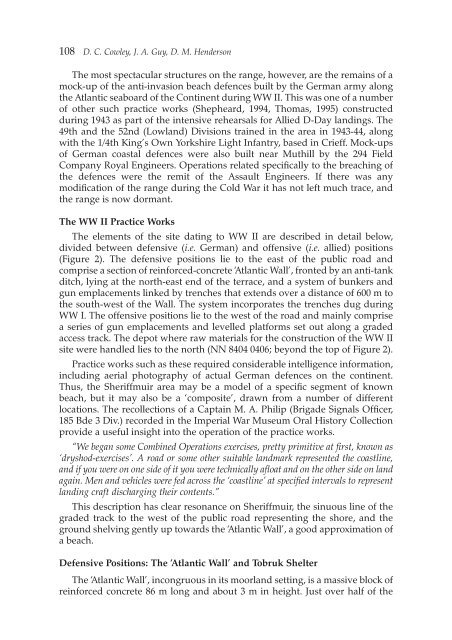the Forth Naturalist Historian - Forth Naturalist and Historian ...
the Forth Naturalist Historian - Forth Naturalist and Historian ...
the Forth Naturalist Historian - Forth Naturalist and Historian ...
You also want an ePaper? Increase the reach of your titles
YUMPU automatically turns print PDFs into web optimized ePapers that Google loves.
108 D. C. Cowley, J. A. Guy, D. M. Henderson<br />
The most spectacular structures on <strong>the</strong> range, however, are <strong>the</strong> remains of a<br />
mock-up of <strong>the</strong> anti-invasion beach defences built by <strong>the</strong> German army along<br />
<strong>the</strong> Atlantic seaboard of <strong>the</strong> Continent during WW II. This was one of a number<br />
of o<strong>the</strong>r such practice works (Shepheard, 1994, Thomas, 1995) constructed<br />
during 1943 as part of <strong>the</strong> intensive rehearsals for Allied D-Day l<strong>and</strong>ings. The<br />
49th <strong>and</strong> <strong>the</strong> 52nd (Lowl<strong>and</strong>) Divisions trained in <strong>the</strong> area in 1943-44, along<br />
with <strong>the</strong> 1/4th King’s Own Yorkshire Light Infantry, based in Crieff. Mock-ups<br />
of German coastal defences were also built near Muthill by <strong>the</strong> 294 Field<br />
Company Royal Engineers. Operations related specifically to <strong>the</strong> breaching of<br />
<strong>the</strong> defences were <strong>the</strong> remit of <strong>the</strong> Assault Engineers. If <strong>the</strong>re was any<br />
modification of <strong>the</strong> range during <strong>the</strong> Cold War it has not left much trace, <strong>and</strong><br />
<strong>the</strong> range is now dormant.<br />
The WW II Practice Works<br />
The elements of <strong>the</strong> site dating to WW II are described in detail below,<br />
divided between defensive (i.e. German) <strong>and</strong> offensive (i.e. allied) positions<br />
(Figure 2). The defensive positions lie to <strong>the</strong> east of <strong>the</strong> public road <strong>and</strong><br />
comprise a section of reinforced-concrete ‘Atlantic Wall’, fronted by an anti-tank<br />
ditch, lying at <strong>the</strong> north-east end of <strong>the</strong> terrace, <strong>and</strong> a system of bunkers <strong>and</strong><br />
gun emplacements linked by trenches that extends over a distance of 600 m to<br />
<strong>the</strong> south-west of <strong>the</strong> Wall. The system incorporates <strong>the</strong> trenches dug during<br />
WW I. The offensive positions lie to <strong>the</strong> west of <strong>the</strong> road <strong>and</strong> mainly comprise<br />
a series of gun emplacements <strong>and</strong> levelled platforms set out along a graded<br />
access track. The depot where raw materials for <strong>the</strong> construction of <strong>the</strong> WW II<br />
site were h<strong>and</strong>led lies to <strong>the</strong> north (NN 8404 0406; beyond <strong>the</strong> top of Figure 2).<br />
Practice works such as <strong>the</strong>se required considerable intelligence information,<br />
including aerial photography of actual German defences on <strong>the</strong> continent.<br />
Thus, <strong>the</strong> Sheriffmuir area may be a model of a specific segment of known<br />
beach, but it may also be a ‘composite’, drawn from a number of different<br />
locations. The recollections of a Captain M. A. Philip (Brigade Signals Officer,<br />
185 Bde 3 Div.) recorded in <strong>the</strong> Imperial War Museum Oral History Collection<br />
provide a useful insight into <strong>the</strong> operation of <strong>the</strong> practice works.<br />
“We began some Combined Operations exercises, pretty primitive at first, known as<br />
‘dryshod-exercises’. A road or some o<strong>the</strong>r suitable l<strong>and</strong>mark represented <strong>the</strong> coastline,<br />
<strong>and</strong> if you were on one side of it you were technically afloat <strong>and</strong> on <strong>the</strong> o<strong>the</strong>r side on l<strong>and</strong><br />
again. Men <strong>and</strong> vehicles were fed across <strong>the</strong> ‘coastline’ at specified intervals to represent<br />
l<strong>and</strong>ing craft discharging <strong>the</strong>ir contents.”<br />
This description has clear resonance on Sheriffmuir, <strong>the</strong> sinuous line of <strong>the</strong><br />
graded track to <strong>the</strong> west of <strong>the</strong> public road representing <strong>the</strong> shore, <strong>and</strong> <strong>the</strong><br />
ground shelving gently up towards <strong>the</strong> ‘Atlantic Wall’, a good approximation of<br />
a beach.<br />
Defensive Positions: The ‘Atlantic Wall’ <strong>and</strong> Tobruk Shelter<br />
The ‘Atlantic Wall’, incongruous in its moorl<strong>and</strong> setting, is a massive block of<br />
reinforced concrete 86 m long <strong>and</strong> about 3 m in height. Just over half of <strong>the</strong>



